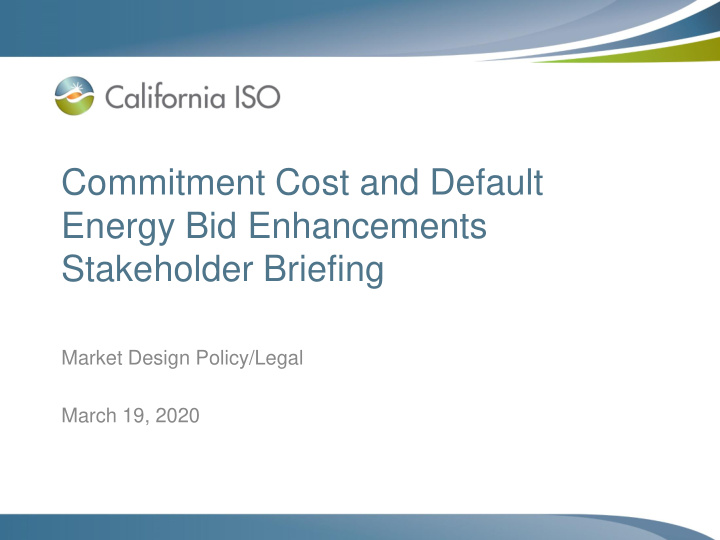



Commitment Cost and Default Energy Bid Enhancements Stakeholder Briefing Market Design Policy/Legal March 19, 2020
New online stakeholder commenting tool coming this Spring • Ability to view all comments with a NOTE NO TE single click. • Ability to filter comments by question or Submitting comments by entity. in the new tool will require a one-time • Login, add your comments directly into registration. the template and submit. o You can save and return to your entry anytime during the open comment period. Page 2
History/Background • March 2018 – CAISO Board of Governors approves CCDEBE proposal – Update commitment costs and default energy bids – Add commitment cost market power mitigation and higher bid caps – Make permanent certain interim Aliso Canyon measures • March 2019 – CAISO Board of Governors approves Local Market Power Mitigation Enhancements proposal – Include more up-to-date gas indices for day-ahead and real-time market (Monday-Only index) Page 3
History/Background continued • June 2019 – Tariff stakeholder process propose two phases to CCDEBE – Phase 1 - Updates to reference level enhancements and make permanent interim Aliso Canyon measures; updated indices rules from LMPME – Phase 2 – Commitment cost market power mitigation and higher bid caps • August 2019 – Filed Phase 1 Tariff at FERC • 2022 – Phase 2 tariff stakeholder process and filing at FERC Page 4
Summary of filing: • Allow suppliers to request adjustments to reference levels • Retain 125% multiplier commitment costs and 110% multiplier to default energy bid costs – Multipliers included in reference level change requests • Allow use of Monday-only index and updates in real-time • Permanently implement interim Aliso Canyon measures – Improve the accuracy of the gas commodity price indices used in day-ahead market – Provide suppliers advisory schedules two days before the trade date) – Clarify that the bid-effectiveness thresholds in the tariff apply to nomograms individual flowgates Page 5
FERC process • October 7, 2019 - CAISO answer to comments and limited protest – Clarified second sentence of proposed section 30.11.1.1 – Typographical and cross-reference errors in Section 30.11.1.1 and 30.11.3.4 (b) – Inadvertent omission of proposed deletion of Section 31.6.1 (v) • November 4, 2019 – FERC issued Deficiency Letter Page 6
FERC process continued • November 22, 2019 – CAISO response to FERC’s deficiency letter – Presented data that supports 10 percent multiplier for fuel costs – Confirmed Monday-only index is severable from the rest of the proposed changes – Clarified gas penalties not accepted in after-the-fact demonstration, proposed adding language to 30.12.1 – Agreed to modify BPM and add language to section 30.11.2.1 to reflect gas penalties to no longer accept before-the-fact verification process – Added clarifications to section 30.11.3.1 regarding prohibition on submitting reference level changes to inflate default energy bids or default commitment cost bids Page 7
FERC January 21, 2020 Order • Approved measures effective January 28, 2020: – Day-ahead updated index – Section 39.7.1.1.1.3 (a)-(c) – Communications prior to DAM – Section 6.5.2.2.3 – Greenhouse gas indices – Section 6.5.2.2.3 – Real-time price index update – Section 6.5.4.2.3 – Deletion of Section 30.4.1.2.(b) – Monday only index – Section 39.7.1.1.1.3 (b)-(c) – Bid effectiveness threshold – Section 27.4.3.6 • Compliance filing due Feb 21 to delete 31.6.1.(v) Page 8
FERC January 21, 2020 Order rejected CCDEDBE changes • FERC explicitly rejected including the 125% multiplier included in calculating commitment costs in the context of reference level changes. • FERC did not rule out the remainder of the proposal Page 9
CAISO plans to resubmit the bulk of the CCDEBE tariff language with changes consistent with FERC’s direction • Data justifies a 110% multiplier in default commitment cost bids given the ability to make reference level adjustments • Propose to reduce the multiplier in default commitment cost bids to 110% Page 10
110% multiplier in the calculation of commitment cost bid caps is still appropriate in the context of reference level adjustments • Captures: – Differences between estimated and actual costs that may change over the day, due to • Automatic reference level adjustments are capped at 110% for the entire day • Manual reference level adjustments are only available in the morning – Hard to define costs – Pre-defined administrative formulas cannot always accurately reflect actual costs • 110% multiplier also eases administrative burden by decreasing the need for reference level adjustment requests Page 11
SoCal-City Gate Hub Prices deviation from weighted average price Page 12
SoCal-City Gate Hub Prices deviation from weighted average price Page 13
PG&E Gate Hub Prices deviation from weighted average price Page 14
Next day price variations – SoCal- Citygate Page 15
Same day variations – SoCal City Gate Page 16
Comments due • Please submit comments by end of day March 26 to initiativecomments@caiso.com • Comments template will be available on the initiative webpage (under today’s meeting header) at http://www.caiso.com/StakeholderProcesses/Commit ment-costs-and-default-energy-bid-enhancements Page 17
Recommend
More recommend